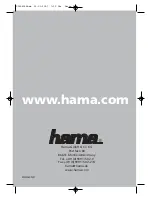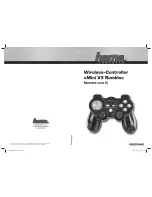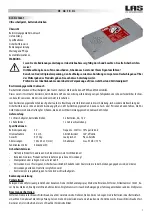
GE Multilin
G60 Generator Protection System
5-173
5 SETTINGS
5.6 GROUPED ELEMENTS
5
•
POWER SWING QUAD REV REACH OUT
: This setting specifies the reverse reach of the outer quadrilateral charac-
teristic. The angle of this reach impedance is specified by the
POWER SWING FWD RCA
setting. The setting is not used if
the shape setting is “Mho”.
•
POWER SWING REV RCA:
This setting specifies the angle of the reverse reach impedance for the mho characteris-
tics. This setting applies to mho shapes only.
•
POWER SWING OUTER LIMIT ANGLE:
This setting defines the outer power swing characteristic. The convention
depicted in the
Power swing detect characteristic
diagram should be observed: values greater than 90° result in an
apple-shaped characteristic; values less than 90° result in a lens shaped characteristic. This angle must be selected in
consideration of the maximum expected load. If the maximum load angle is known, the outer limit angle should be
coordinated with a 20° security margin. Detailed studies may be needed for complex systems to determine this setting.
This setting applies to mho shapes only.
•
POWER SWING MIDDLE LIMIT ANGLE:
This setting defines the middle power swing detect characteristic. It is rele-
vant only for the 3-step mode. A typical value would be close to the average of the outer and inner limit angles. This
setting applies to mho shapes only.
•
POWER SWING INNER LIMIT ANGLE:
This setting defines the inner power swing detect characteristic. The inner
characteristic is used by the out-of-step tripping function: beyond the inner characteristic out-of-step trip action is defi-
nite (the actual trip may be delayed as per the
TRIP MODE
setting). Therefore, this angle must be selected in consider-
ation to the power swing angle beyond which the system becomes unstable and cannot recover.
The inner characteristic is also used by the power swing blocking function in the two-step mode. In this case, set this
angle large enough so that the characteristics of the distance elements are safely enclosed by the inner characteristic.
This setting applies to mho shapes only.
•
POWER SWING OUTER
,
MIDDLE
, and
INNER RGT BLD
: These settings specify the resistive reach of the right
blinder. The blinder applies to both “Mho” and “Quad” characteristics. Set these value high if no blinder is required for
the “Mho” characteristic.
•
POWER SWING OUTER
,
MIDDLE
, and
INNER LFT BLD
: These settings specify the resistive reach of the left blinder.
Enter a positive value; the relay automatically uses a negative value. The blinder applies to both “Mho” and “Quad”
characteristics. Set this value high if no blinder is required for the “Mho” characteristic.
•
POWER SWING PICKUP DELAY 1:
All the coordinating timers are related to each other and should be set to detect
the fastest expected power swing and produce out-of-step tripping in a secure manner. The timers should be set in
consideration to the power swing detect characteristics, mode of power swing detect operation and mode of out-of-
step tripping. This timer defines the interval that the impedance locus must spend between the outer and inner charac-
teristics (two-step operating mode), or between the outer and middle characteristics (three-step operating mode)
before the power swing blocking signal is established. This time delay must be set shorter than the time required for
the impedance locus to travel between the two selected characteristics during the fastest expected power swing. This
setting is relevant for both power swing blocking and out-of-step tripping.
•
POWER SWING RESET DELAY 1:
This setting defines the dropout delay for the power swing blocking signal. Detec-
tion of a condition requiring a block output sets latch 1 after
PICKUP DELAY 1
time. When the impedance locus leaves
the outer characteristic, timer
POWER SWING RESET DELAY 1
is started. When the timer times-out the latch is reset. This
setting should be selected to give extra security for the power swing blocking action.
•
POWER SWING PICKUP DELAY 2:
Controls the out-of-step tripping function in the three-step mode only. This timer
defines the interval the impedance locus must spend between the middle and inner characteristics before the second
step of the out-of-step tripping sequence is completed. This time delay must be set shorter than the time required for
the impedance locus to travel between the two characteristics during the fastest expected power swing.
•
POWER SWING PICKUP DELAY 3:
Controls the out-of-step tripping function only. It defines the interval the imped-
ance locus must spend within the inner characteristic before the last step of the out-of-step tripping sequence is com-
pleted and the element is armed to trip. The actual moment of tripping is controlled by the
TRIP MODE
setting. This time
delay is provided for extra security before the out-of-step trip action is executed.
•
POWER SWING PICKUP DELAY 4:
Controls the out-of-step tripping function in “Delayed” trip mode only. This timer
defines the interval the impedance locus must spend outside the inner characteristic but within the outer characteristic
before the element is armed for the delayed trip. The delayed trip occurs when the impedance leaves the outer charac-
teristic. This time delay is provided for extra security and should be set considering the fastest expected power swing.
Summary of Contents for Multilin g60
Page 10: ...x G60 Generator Protection System GE Multilin TABLE OF CONTENTS INDEX ...
Page 32: ...1 22 G60 Generator Protection System GE Multilin 1 5 USING THE RELAY 1 GETTING STARTED 1 ...
Page 160: ...4 30 G60 Generator Protection System GE Multilin 4 3 FACEPLATE INTERFACE 4 HUMAN INTERFACES 4 ...
Page 486: ...5 326 G60 Generator Protection System GE Multilin 5 10 TESTING 5 SETTINGS 5 ...
Page 518: ...6 32 G60 Generator Protection System GE Multilin 6 5 PRODUCT INFORMATION 6 ACTUAL VALUES 6 ...
Page 532: ...7 14 G60 Generator Protection System GE Multilin 7 2 TARGETS 7 COMMANDS AND TARGETS 7 ...
Page 748: ...D 10 G60 Generator Protection System GE Multilin D 1 IEC 60870 5 104 APPENDIX D D ...
Page 760: ...E 12 G60 Generator Protection System GE Multilin E 2 DNP POINT LISTS APPENDIX E E ...
















































